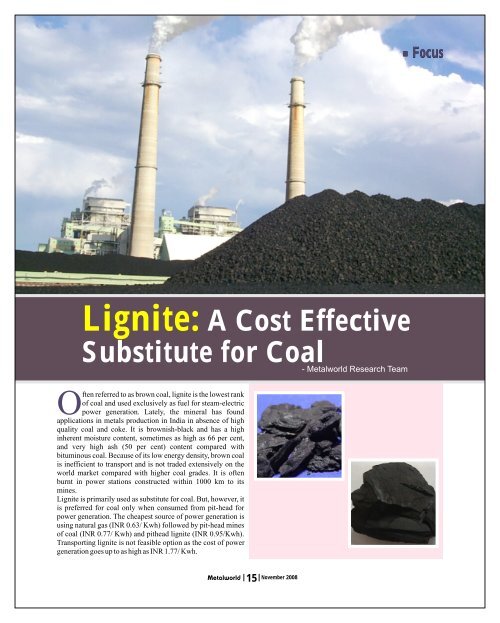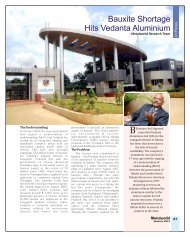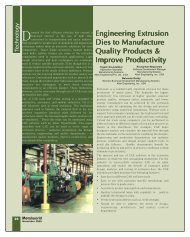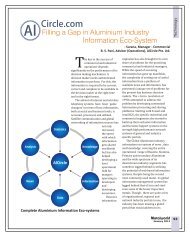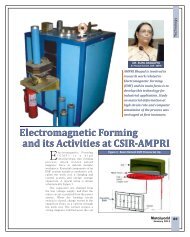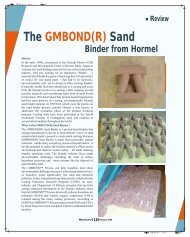Lignite: A Cost Effective Substitute for Coal - Metalworld.co.in
Lignite: A Cost Effective Substitute for Coal - Metalworld.co.in
Lignite: A Cost Effective Substitute for Coal - Metalworld.co.in
You also want an ePaper? Increase the reach of your titles
YUMPU automatically turns print PDFs into web optimized ePapers that Google loves.
Focus<strong>Lignite</strong>: A <strong>Cost</strong> <strong>Effective</strong><strong>Substitute</strong> <strong>for</strong> <strong>Coal</strong>- <strong>Metalworld</strong> Research TeamOften referred to as brown <strong>co</strong>al, lignite is the lowest rankof <strong>co</strong>al and used exclusively as fuel <strong>for</strong> steam-electricpower generation. Lately, the m<strong>in</strong>eral has foundapplications <strong>in</strong> metals production <strong>in</strong> India <strong>in</strong> absence of highquality <strong>co</strong>al and <strong>co</strong>ke. It is brownish-black and has a high<strong>in</strong>herent moisture <strong>co</strong>ntent, sometimes as high as 66 per cent,and very high ash (50 per cent) <strong>co</strong>ntent <strong>co</strong>mpared withbitum<strong>in</strong>ous <strong>co</strong>al. Because of its low energy density, brown <strong>co</strong>alis <strong>in</strong>efficient to transport and is not traded extensively on theworld market <strong>co</strong>mpared with higher <strong>co</strong>al grades. It is oftenburnt <strong>in</strong> power stations <strong>co</strong>nstructed with<strong>in</strong> 1000 km to itsm<strong>in</strong>es.<strong>Lignite</strong> is primarily used as substitute <strong>for</strong> <strong>co</strong>al. But, however, itis preferred <strong>for</strong> <strong>co</strong>al only when <strong>co</strong>nsumed from pit-head <strong>for</strong>power generation. The cheapest source of power generation isus<strong>in</strong>g natural gas (INR 0.63/ Kwh) followed by pit-head m<strong>in</strong>esof <strong>co</strong>al (INR 0.77/ Kwh) and pithead lignite (INR 0.95/Kwh).Transport<strong>in</strong>g lignite is not feasible option as the <strong>co</strong>st of powergeneration goes up to as high as INR 1.77/ Kwh.15November 2008
FocusWorldwide about 79per cent of lignite <strong>co</strong>alis used to generateelectricity, 13.5 percent is used togenerate syntheticnatural gas, and 7.55per cent is used toproduce fertilizerproducts (anhydrousammonia andammonium sulfate).ApplicationIn IndiaWorldwide about 79 per cent of lignite <strong>co</strong>al <strong>Coal</strong> and lignite <strong>in</strong>dustry <strong>in</strong> India operatesis used to generate electricity, 13.5 per cent under a strictly <strong>co</strong>ntrolled regime and is stillis used to generate synthetic natural gas, and under government <strong>co</strong>ntrol. The M<strong>in</strong>es and7.55 per cent is used to produce fertilizer M<strong>in</strong>eral Act, 1957 <strong>co</strong>nstitutes basic lawsproducts (anhydrous ammonia and govern<strong>in</strong>g the m<strong>in</strong><strong>in</strong>g sector <strong>in</strong> India and theammonium sulfate). A very small <strong>co</strong>al sector also <strong>co</strong>mes under its purview.percentage is used as home heat<strong>in</strong>g fuel, <strong>for</strong> Be<strong>for</strong>e notification No.38035/2/97-CAuse as fertilizer and <strong>for</strong> use as oil well dated 12th December, 2001 only Centraldrill<strong>in</strong>g mud.government was allowed <strong>for</strong> <strong>co</strong>al andlignite m<strong>in</strong><strong>in</strong>g. But the notification alloweds t a t e g o v e r n m e n t c o m p a n i e s o rundertak<strong>in</strong>gs to m<strong>in</strong>e <strong>co</strong>al and ligniteanywhere <strong>in</strong> the <strong>co</strong>untry with follow<strong>in</strong>g<strong>co</strong>nditions:a) For <strong>co</strong>al and lignite m<strong>in</strong><strong>in</strong>g, the will<strong>in</strong>g<strong>co</strong>mpanies need to obta<strong>in</strong> permission fromthe government <strong>co</strong>ntrolled <strong>Coal</strong> India Ltd(CIL) and Neyveli <strong>Lignite</strong> Corporation(NLC) respectively?b) M<strong>in</strong><strong>in</strong>g leases can be granted to stategovernment <strong>co</strong>mpanies or undertak<strong>in</strong>gsonly if CIL and NLC have no plan orwill<strong>in</strong>gness to undertake m<strong>in</strong><strong>in</strong>g operationsBesides its application <strong>in</strong> power generation, <strong>for</strong> <strong>co</strong>al or lignite <strong>in</strong> the <strong>co</strong>ncerned area.the m<strong>in</strong>eral also f<strong>in</strong>ds applications <strong>in</strong> c) The proposed m<strong>in</strong><strong>in</strong>g area has not beenvarious other sectors <strong>in</strong>clud<strong>in</strong>g cement, allotted to any captive m<strong>in</strong><strong>in</strong>g <strong>co</strong>mpany.paper, soda ash and chemicals, bricks and (Can be any private or public <strong>co</strong>mpany).ceramics, textiles, and many other Occurrence of lignite <strong>in</strong> India is <strong>co</strong>nf<strong>in</strong>ed tomiscellaneous sectors. Demand <strong>for</strong> lignite the southern states of Tamil Nadu andfrom such sectors is expected to grow at a Kerala, western states of Gujarat and<strong>co</strong>mpounded annual growth rate (CAGR) Rajasthan and eastern states of Pondicherry,of 12 per cent from 8.3 million tons <strong>in</strong> 2007- Jammu & Kashmir, where <strong>co</strong>al availability08 to 20 million tons <strong>in</strong> 2011-12. is almost 'nil'. In view of rapidly <strong>in</strong>creas<strong>in</strong>gR e q u i r e m e n t b y t h e s e s e c t o r s demand <strong>for</strong> energy, non availability of <strong>co</strong>al<strong>in</strong>dependently are very m<strong>in</strong>iscule <strong>in</strong> deposits <strong>for</strong> exploitation <strong>in</strong> the states of<strong>co</strong>mparison to power sector standalone. For Tamil Nadu, Gujarat and Rajasthan,limited requirement by these <strong>in</strong>dustries, it is problems faced <strong>in</strong> the transportation of <strong>co</strong>alnot feasible <strong>for</strong> them to have their captive from far off <strong>co</strong>alfields and high <strong>co</strong>stlignite m<strong>in</strong>es and as a result such <strong>in</strong>dustries <strong>in</strong>volved <strong>in</strong> transport<strong>in</strong>g <strong>co</strong>al over a longmeet their lignite needs from merchant distance, it is <strong>co</strong>nsidered necessary that thesellers.lignite deposits available <strong>in</strong> these states are16November 2008
Focusexploited <strong>for</strong> power generation whichwould be the best e<strong>co</strong>nomic and viableoption.<strong>Cost</strong> and Pric<strong>in</strong>g Structurefrom lignite fueled power stations. NLC,Gujarat Industrial and power <strong>co</strong>mpany Ltd(GIPCL), Gujarat M<strong>in</strong>eral DevelopmentCorporation Ltd (GMDC) are some of thePrices of <strong>co</strong>al and lignite are based on<strong>co</strong>st<strong>in</strong>g and a particular profit marg<strong>in</strong>.<strong>Cost</strong><strong>in</strong>g generally <strong>in</strong>cludes <strong>co</strong>st of land, <strong>co</strong>stof <strong>for</strong>estation, other capital <strong>co</strong>sts(appropriately apportioned over the life ofthe project, and other operat<strong>in</strong>g <strong>co</strong>sts.Ris<strong>in</strong>g Production<strong>Lignite</strong> production <strong>in</strong>India has been<strong>co</strong>nt<strong>in</strong>uously<strong>in</strong>creas<strong>in</strong>g, backed bydemand from lignitefueled powerstations.<strong>Lignite</strong> production <strong>in</strong> India has been<strong>co</strong>nt<strong>in</strong>uously <strong>in</strong>creas<strong>in</strong>g, backed by demandSource: M<strong>in</strong>istry of power<strong>co</strong>mpanies who have been sett<strong>in</strong>g uplignite-based power plants <strong>in</strong> theirrespective states. As a result of such<strong>co</strong>nt<strong>in</strong>uously ris<strong>in</strong>g demand <strong>for</strong> lignite, itsproduction has <strong>in</strong>creased from 20.8 milliontons <strong>in</strong> 1999-00 to 32 million tons <strong>in</strong> 2006-07 at a <strong>co</strong>mpounded annual growth rate(CAGR) of 7 per cent.Demand RationaleThe low <strong>co</strong>st of power generation us<strong>in</strong>g17November 2008
FocusDemand is expectedto grow at a CAGR 12per cent from 35.84million tons <strong>in</strong> 2007-08 to 55.93 per centtons <strong>in</strong> 2011-12especially fromRajasthan andGujarat with several<strong>in</strong>itiatives taken bythese governments.<strong>co</strong>al/lignite, and the availability of huge which <strong>co</strong>al and lignite ac<strong>co</strong>unts <strong>for</strong> nearly<strong>co</strong>al/lignite reserves <strong>in</strong> India, are some of 83 per cent.the major <strong>in</strong>centives <strong>for</strong> sett<strong>in</strong>g up Demand is expected to grow at a CAGR 12<strong>co</strong>al/lignite-based power plants. per cent from 35.84 million tons <strong>in</strong> 2007-Currently, <strong>in</strong> India, thermal power ac<strong>co</strong>unt 08 to 55.93 per cent tons <strong>in</strong> 2011-12<strong>for</strong> 65 per cent of total power generation of especially from Rajasthan and Gujaratwith several <strong>in</strong>itiatives taken by thesegovernments.Nearly 2225 MW lignite based powerplants are expected to be <strong>in</strong>stalled <strong>in</strong> XIplan to be <strong>co</strong>mpleted by 2012.ConclusionWith grow<strong>in</strong>g energy demand fromdomestic and <strong>in</strong>dustry sectors alike,lignite is likely to rema<strong>in</strong> <strong>in</strong> <strong>for</strong>efront <strong>in</strong>future.


